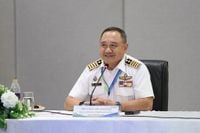Thailand's aviation sector is on the brink of transformation as the Civil Aviation Authority of Thailand (CAAT) embarks on an ambitious project to elevate the country's status to a regional aviation hub. This initiative comes after Thailand successfully upgraded its aviation standards from Category 2 (CAT2) back to Category 1 (CAT1), a move that aligns the nation with international aviation standards.
According to CAAT's Director, Air Chief Marshal Manat Chuanaprayoon, the Aviation Hub project aims to integrate various components including Maintenance, Repair and Overhaul (MRO) centers, comprehensive training centers, and enhancements to air cargo services. “We are confident that with the right strategies, Thailand can become a central aviation hub in the region,” he stated following the kickoff meeting for the Aviation Hub policy.
The initiative will see the establishment of MRO centers that will not only cater to local airlines but will also attract international carriers looking for maintenance services. The goal is to make Thailand a preferred stop for airlines needing aircraft repairs and overhauls. This includes forming partnerships with global companies to ensure that a variety of maintenance services are available, whether it be for Boeing or Airbus aircraft.
“Airlines that wish to bring their planes for maintenance in Thailand will have more options,” Air Chief Marshal Manat explained. “They can choose to work with companies they trust or explore other options available. This choice will undoubtedly increase our customer base and solidify our position as an Aviation Hub.”
In addition to MRO services, CAAT is also focused on bolstering the air cargo sector. The authority plans to reduce barriers to entry for Thai air cargo operators, which includes revising regulations regarding foreign ownership in the aviation industry. This approach aims to encourage more Thai entrepreneurs to enter the air cargo market, ultimately leading to a more robust national airline capable of competing on an international level.
The establishment of an Aviation Training Centre is another critical component of the Aviation Hub project. CAAT is preparing to create training facilities at key airports such as Suvarnabhumi, Don Mueang, and Phuket. These centers will utilize cutting-edge technology and adhere to international standards to train personnel in various aviation fields. The training will include simulated flight operations, aircraft maintenance, and air traffic control.
“We expect to finalize the plan for the training center by 2026,” Air Chief Marshal Manat noted. “Our aim is to ensure that the workforce is well-equipped to handle the growth in the aviation industry.”
Furthermore, CAAT is also looking into expanding general aviation services, which includes private jet facilities and drone operations. The authority plans to enhance airport facilities to attract high-spending tourists and review regulations surrounding the operation of private jets and drones. This is part of a broader strategy to integrate modern aviation practices into Thailand’s airspace.
“We are committed to developing the necessary infrastructure and regulatory framework to support these initiatives,” said Air Chief Marshal Manat. “Our goal is to ensure that Thailand not only meets but exceeds international aviation standards.”
The Aviation Hub project is seen as a vital step toward ensuring the sustainability of Thailand's aviation industry. As the country positions itself as a key player in the regional aviation market, CAAT emphasizes the importance of collaboration among government, private sectors, and international partners to achieve these ambitious goals.
On a separate note, the Royal Thai Air Force reported an incident on May 6, 2025, when an unidentified aircraft resembling a K-8 jet was detected near the Thai-Myanmar border in Kanchanaburi province. The Air Force deployed two F-16 fighter jets from Wing 4 in Nakhon Sawan to investigate the situation.
According to Air Force spokesperson, Air Vice Marshal Prapas Sonjaidee, the aircraft was identified as a non-military K-8 jet. The deployment of F-16s was a precautionary measure to secure the area and prevent any potential breaches of sovereignty. Fortunately, the Air Force confirmed that no violations occurred and there were no casualties reported.
“We are prepared to respond to any unidentified aircraft and will take necessary actions to protect Thai airspace,” Air Vice Marshal Prapas stated. “Our mission is to uphold the sovereignty of the nation while adhering to international laws and obligations.”
This incident underscores the importance of maintaining vigilant airspace security as Thailand moves forward with its plans to enhance its aviation capabilities. The dual focus on becoming a regional aviation hub while ensuring national security highlights the complexities of modern aviation management.
As Thailand continues to develop its aviation infrastructure and services, the collaboration between CAAT and the Royal Thai Air Force will be crucial in navigating the challenges of both enhancing the aviation sector and ensuring air sovereignty.




